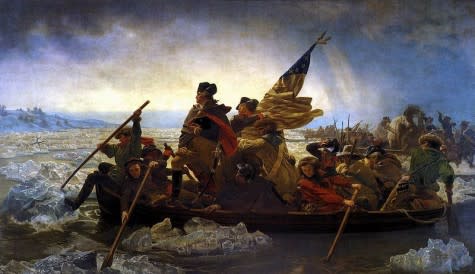Washington’s Crossing as it happened
On a blustery Christmas Day in late 1776, George Washington led a daring attack in what we would call today a “special ops” mission to attack pro-British forces in Trenton.
At midday today, historical re-enactors will celebrate the event by crossing the Delaware River in front of several thousand people, in a relatively safe event. The event, about nine miles north of Trenton, is held in bucolic Washington Crossing, Pennsylvania.
The real event was at night, it was dangerous, and it was a key moment in the history of the Continental Army. And it bore little resemblance to the famous 19th-century painting marking the daring feat.
Washington’s army had been issued a series of defeats by British forces and were amassed between Philadelphia and Princeton. As a commander, Washington dealt with several critical problems: his forces were in need of a victory; many troops were at the end of their enlistment; and winter was ready to set in.
Across and down the river were the Hessians, a garrison of German mercenaries hired by the British. Led by Johann Rall, a 36-year veteran who had served under Catherine the Great in Russia, the Hessians had about 1,200 battle-seasoned troops in position.
Washington had twice as many soldiers across the river. But he faced the prospect of losing much of his volunteer army in just a few days.
The decision to attack the Hessians was made a few days before Christmas, and then a major storm, possibly a Nor’easter, hit the region on Christmas.
Washington used the storm to cover the invasion, and he had already decided to cross under the cover of darkness. The colonists had expert mariners from New England who were able to use local shallow-draft boats, to ferry all the troops across the icy river–unnoticed.
Only a few officers knew of the attack plans. The rest of the troops were told they we going on a secret expedition.
The Hessians also called off their advance patrols during the Nor’easter.
Somehow, Washington executed the crossing in the middle of the storm as ice chunks bobbed in the river as hurricane-strength winds hit.
Early the next morning, Washington led the army into Trenton, where it was spotted by the Hessians. Rall also may have been notified but didn’t act, probably not believing anyone would stage such a risky operation.
In the battle, Washington outflanked the Hessians and also had brought artillery for the occasion. Rall was killed in action and the Hessians were defeated. About 1,000 prisoners were taken.
It was the first of three victories for Washington in the brief campaign, which restored Colonial faith in the army.
Young Lieutenant James Monroe was heroic in the fighting and was promoted. Other prominent Americans in Washington’s camp were Alexander Hamilton and John Marshall.
In addition to energizing the spirits of his army, Washington had instilled a new respect in the British for the resolve and the military abilities of the “rebels.”



